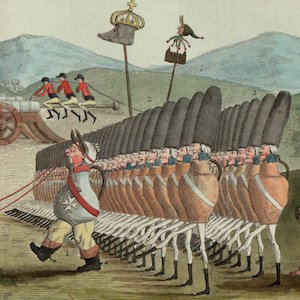Nationalism

The Third Incident of 14 July 1789
This engraving from the Berthault series depicts Stanislas Maillard bravely climbing on a plank over the dry moat surrounding the fortress to accept from one of the soldiers Launay’s "capitulation" of the Bastille.

Taking of the Bastille
This color print emphasizes the populace’s participation in the storming of the Bastille, showing the urban population fighting under a red banner with muskets, swords, and pikes against the royal soldiers.

Taking of Weapons at the Invalides
From the City Hall, the crowd that had gathered on the morning of 14 July crossed the Seine River and sacked the royal veterans’ hospital known as the Invalides, where it hoped to capture arms. In Berthault’s engraving, the scene appears chaotic.

Fusillade in the Faubourg St. Antoine, 28 April 1789
This image chronicles a riot. Many believe it was caused by artisans who attacked the Reveillon wallpaper shop and factory because they believed that the owner was about to lower wages. Over two days, more than 6,000 attacked the place. On 28 April troops were called and fired on the crowd.

Fraternity
Using a woman to represent "Fraternity" seems ironic at best, although theoretically the term might mean the community of humanity. In actuality, when the revolutionaries considered "community," they certainly thought of men far more than women.

National Assembly Relinquishes All Privileges
This image, part of a series produced to show the most important events of the Revolution, focuses on 4 and 5 August 1789, when the system of privileges came to an end. This legal structure, characteristic of the old regime, guaranteed different rights for different people.

Transportation of Voltaire to the French Panthéon, 8 July 1792
Although Voltaire’s contribution to the Revolution has been much debated, the revolutionaries themselves had absolutely no doubt of his significance. After 1789 he was much in vogue, in that his plays were often performed and other artists lionized him in various ways.

Army of Jugs
This color drawing, produced in 1793 at the request of the Committee of Public Safety and then published as an engraving, caricatures the British army and its king, George III, as incompetent, who, despite fine uniforms, cannot defeat shoddily clad, yet energetic sans–culottes (on the left), who

An Emblematical View of the Constitutions of England and France
Similar to the two engravings of trees, this engraving contrasts English order with French anarchy. On the left, a lion (representing England) sits at the foot of a chiseled rock, part of which is labeled "Unanimity." A crown appears over the rock; a unicorn lies behind it.

Ah! Monsignor!
Not uncommonly, revolutionary prints invoked excretory humor directed toward those priests who would not swear allegiance to the Revolution. Revolutionaries eliminated on their enemies; the latter might also receive enemas.